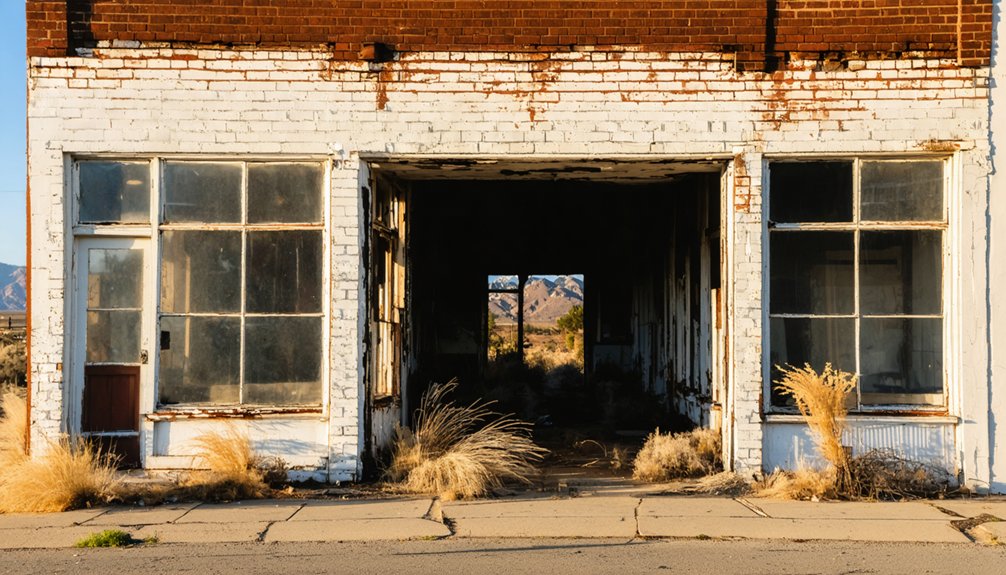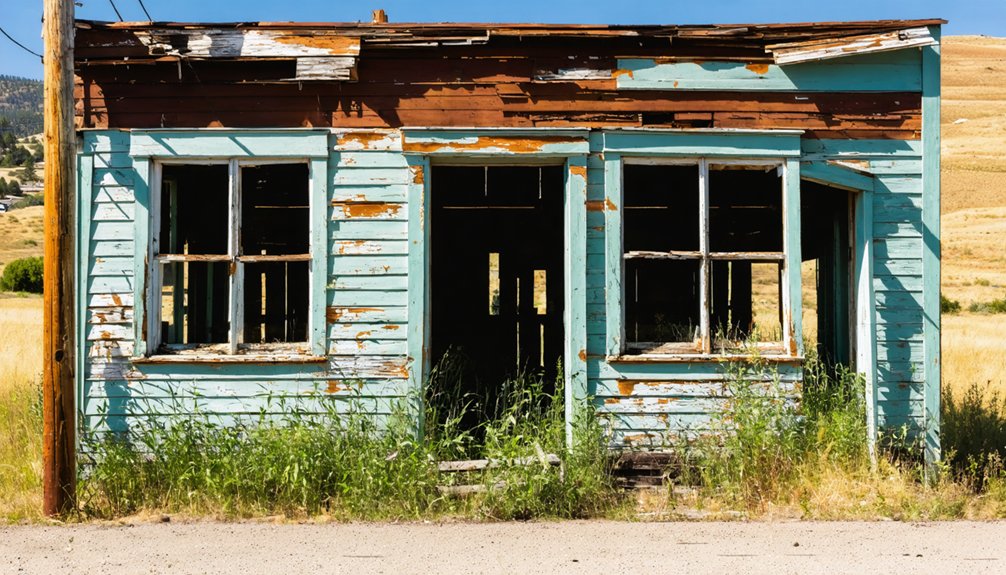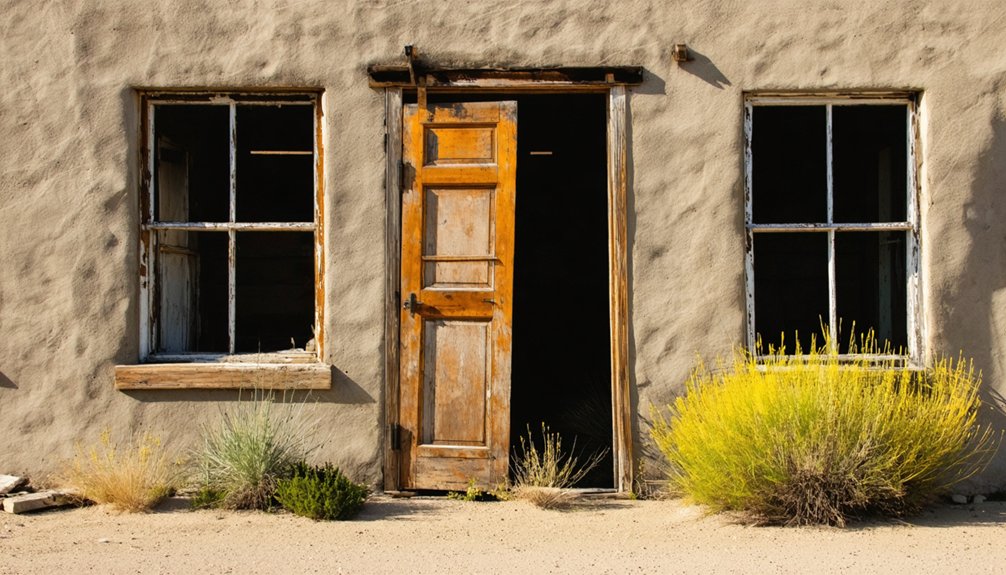Hamilton, California was a booming silver mining town established in 1867 near the Feather River in Butte County. You’ll find it 15 miles downstream from Oroville, where miners initially lived in cave dwellings carved from volcanic tuff. At its peak in 1869, the population swelled to 10,000 before declining as ore deposits diminished. Three devastating fires between 1885 and the early 1900s sealed its fate, leaving only stone foundations where prosperity once thrived.
Key Takeaways
- Hamilton was established in 1867 near Oroville, California, evolving from Cave City after significant silver discoveries in the region.
- Early miners created sophisticated cave dwellings in volcanic tuff, some of which remained inhabited until the 1970s.
- The town’s population peaked at 10,000 residents in 1869 during the silver boom before declining as ore deposits diminished.
- Hamilton’s prosperity was short-lived, with three major fires between 1885 and the early 1900s leading to its abandonment.
- Today, only stone foundations and rubble remain of the once-thriving mining town located in Butte County.
The Geographic Setting of California’s Forgotten Silver Settlement
Nestled within the embrace of Butte County, California, the forgotten settlement of Hamilton lies on the western banks of the Feather River, a silent testimony to the state’s silver mining past.
You’ll find this ghost town approximately 15 miles downstream from Oroville, positioned at 39°27′16″N 121°38′23″W in the heart of California’s Gold Country.
Unlike its higher-elevation counterparts in Nevada’s White Pine District, Hamilton occupied the accessible terrain of the Sacramento Valley’s edge, where the Sierra foothills meet the valley floor.
Where California’s foothills surrender to valley flatlands, Hamilton found its place—accessible unlike the lofty mining outposts of Nevada.
This strategic location offered vital access to water resources necessary for processing mining materials.
The surrounding geographic features provided both the mining resources that sparked Hamilton’s creation and the transportation corridors that connected it to other emerging settlements throughout Northern California’s rapidly developing frontier. The actual Hamilton ghost town was established in 1867 after significant silver discoveries, not in California as described here but in Nevada. Visitors researching this location should consult a proper disambiguation page to avoid confusion with similarly named locations.
From Cave City to Hamilton: The Birth of a Mining Community
You’ll find Cave City’s early miners initially sought shelter in natural caverns before Hamilton emerged as a proper settlement.
John Bidwell’s 1848 gold discovery transformed what began as primitive dwellings into a vision for a permanent community, complete with a name honoring Alexander Hamilton’s nephew.
The rapid shift from isolated claims to an organized town brought taverns, stores, a blacksmith shop, and government offices—all hallmarks of a mining community determined to establish permanence amid the chaotic California Gold Rush. Mining techniques evolved from simple placer operations with gold pans and sluice boxes to more organized efforts involving wingdams and drift mining. Hamilton’s history mirrors many Nevada mining settlements that experienced explosive growth, peaking at over 10,000 residents in 1869 before declining dramatically as ore deposits diminished.
Early Cave Dwellings
Three distinct forms of shelter marked the evolution of Cave City before it became Hamilton. Initially, miners seeking freedom carved dwellings into the soft volcanic tuff, creating surprisingly sophisticated cave architecture that included multi-roomed structures with split levels for efficient living space.
These cave homes weren’t temporary solutions—they offered natural insulation and protection from the elements that suited the rugged miner lifestyle. Despite their humble origins, these structures proved remarkably durable, with some reportedly inhabited as late as the 1970s. Archaeological techniques similar to those used in Sacramento Valley sites have helped researchers understand the chronological development of these unique cave dwellings.
As placer claims yielded their treasures along McKinney Creek, more conventional structures appeared, though many were abandoned after 1860 when gold production waned. The area reached its mining peak in 1855 with over 400 miners working the rich placers of the region.
The caves’ historical significance lives on today, carefully monitored and protected against vandalism—silent witnesses to the area’s transformation from primitive camp to formal mining town.
Hamilton Founders’ Vision
Ambition and optimism drove the metamorphosis of primitive Cave City into the formal settlement of Hamilton in the late 1840s. Named after Alexander Hamilton’s nephew, the town emerged from John Bidwell’s 1848 gold discovery, sparking the founders’ aspirations for a permanent mining hub.
You’d recognize their vision in every cornerstone they laid—the relocated courthouse, the $9,200 jail with sheet-iron protection, and essential businesses that anchored civic life. They weren’t merely building structures; they were crafting community resilience through property taxation and civic infrastructure. By 1870, the booming town population had grown to become part of the 24,000 residents throughout the area.
Hamilton’s founders envisioned more than a fleeting gold camp. They sought permanence through governance, positioning their settlement as a county seat with taverns fostering social bonds and officials working from improvised hotel offices—practical solutions for ambitious dreams. This vision temporarily materialized when Hamilton became the first county seat of White Pine County in 1869, fulfilling their civic aspirations.
Transitioning Mining Settlement
While Cave City’s primitive shelters foreshadowed Hamilton’s future, the true birth of this significant mining community emerged from the remarkable silver strike of 1865 in the White Pine district.
You’d have witnessed unprecedented excitement in 1868 when Treasure Hill revealed its silver riches, triggering one of history’s most intense mining stampedes.
Imagine joining 10,000 souls who rushed to establish themselves in this harsh mountain terrain, where innovative mining techniques evolved rapidly to extract wealth from elevations of 8,000-10,500 feet.
Community dynamics transformed dramatically as Chinese laborers arrived, and a proper city materialized with brick buildings replacing makeshift shelters. Hamilton’s significance was officially recognized when it became the first county seat of White Pine County after its incorporation in 1869.
Much like Ezra Hamilton’s measured approach to mining in the Mojave Desert, the community practiced sustainable extraction methods to ensure long-term prosperity rather than quick depletion.
The Great Silver Strike and Population Explosion
You’d scarcely believe the speed with which Hamilton transformed after the monumental 1868 silver discovery on Treasure Hill, where veins of silver-rich ore yielded nearly $4,000 per ton—forty times what miners considered profitable.
Within months, the population swelled to 10,000 fortune-seekers who constructed banks, businesses, and a courthouse as Hamilton rapidly became White Pine County’s first seat.
This overnight prosperity established a gambling culture and speculative economy that would define Nevada’s identity for decades, even as Hamilton’s glory proved tragically short-lived.
Overnight Wealth Creation
Fortune and fate converged on Sun Mountain in June 1859, when miners Patrick McLaughlin and Peter O’Riley uncovered what would become one of the most significant mineral discoveries in American history.
The “blue stuff” these men had once discarded proved to be silver concentrate worth nearly $4,000 per ton—forty times what miners considered impressive yields. You could witness overnight fortunes emerging from the earth as assayer Melville Atwood confirmed the remarkable potential on June 27, 1859.
News spread quickly after the July 1 Nevada Journal report, triggering a rush rivaling the ’49 Gold Rush. Throughout the region’s fleeting prosperity, miners extracted $22 million in silver over two decades.
Even in the 1920s, a revival claim yielded $1.2 million in just two years—a demonstration of the extraordinary wealth that transformed ordinary men into mining barons.
Treasure Hill’s Silver Vein
In the shadow of the Comstock’s fame, Treasure Hill emerged as one of the West’s most astounding silver strikes in 1867, yielding ore that assayed at an unprecedented $15,000 per ton—over three times richer than its Nevada predecessor.
You’d have witnessed the “White Pine Excitement” transform barren landscape into bustling civilization as silver’s economic impact rippled across the West.
The region’s wealth manifested through:
- The Hidden Treasure Mine’s extraordinary silver assays reaching $15,000-$20,000 per ton
- An astounding $22 million in silver production over just 20 years
- The Eberhardt mine’s legendary $3 million yield from a single excavation
As miners abandoned neighboring boomtowns, you’d have found yourself amid the densest concentration of wealth-seekers the frontier had ever witnessed, all chasing Treasure Hill’s legendary silver veins.
Boomtown’s Rapid Growth
While Treasure Hill’s silver veins attracted wealth-seekers to neighboring camps, Hamilton’s own silver story began with a dramatic flourish in the early 1880s. You could witness the classic boomtown dynamics as hundreds flocked to stake claims after high-grade ore assays spread like wildfire.
The settlement transformed overnight—miners hacked temporary shelters from local timber as saloons, general stores, and boarding houses sprouted along hastily-planned streets.
Mining culture dominated every aspect of life, with men working claims by day and filling raucous saloons by night. Wealth circulated rapidly as mine payrolls fueled local businesses, and outside investors poured capital into promising claims.
While initially male-dominated, families soon arrived, establishing a semblance of permanence as crushing mills and smelters multiplied to process the silver bounty.
Everyday Life in a Booming California Mining Town
As Hamilton, California rapidly transformed from a barren settlement to a bustling mining community in the early 1850s, everyday life took on a distinctly improvised character that reflected the town’s hasty growth.
The mining community adapted to severely limited civic infrastructure, with Tom Gray’s hotel doubling as government headquarters and “Mother Nichols” hosting court proceedings in her own home.
You’d find daily life organized around these essentials:
- Makeshift shelter – from tents and caves to proper housing as construction caught up with population
- Social gatherings centered at the town’s two competing taverns, where you’d exchange news and enjoy respite
- Basic services provided by the post office, general store, and blacksmith – lifelines that kept the town functioning
Commercial and Civic Development at Hamilton’s Peak

The thriving settlement of Hamilton reached its commercial zenith in 1852, when nearly two dozen businesses lined its hastily constructed main street.
Walking through town, you’d find yourself among a diverse array of establishments — from saloons and general mercantiles to assay offices and equipment suppliers, all serving the needs of the growing population.
The ghost town architecture revealed a community in flux from temporary camp to permanent settlement.
Standing between worlds, Hamilton’s buildings chronicled the evolution from gold rush fever to civic permanence.
Wooden facades replaced canvas tents as prosperity allowed for more substantial construction. Civic institutions emerged alongside commercial ventures, with a rudimentary courthouse, jail, and post office establishing order.
Mining community dynamics shaped Hamilton’s development, with social hierarchies forming between mine owners, merchants, and laborers.
Despite its brief existence, this settlement exemplified the entrepreneurial spirit that defined California’s gold country communities.
The Three Fires: Destruction and Abandonment
Devastating as they were unexpected, three major fires ultimately sealed Hamilton’s fate, transforming a once-bustling mining community into the barren ghost town you’d find today.
The first blaze in 1885 ravaged county buildings, prompting the relocation of the county seat to Ely and triggering the initial wave of abandonment.
The fire impact unfolded in three distinct phases:
- 1885 – First major fire destroyed civic infrastructure, crippling government functions
- 1895 – Second fire consumed remaining wooden structures, eliminating habitable buildings
- Decades later – Final fire razed anything left standing, completing the transformation
What you’ll discover now is merely stone foundations and scattered rubble where prosperity once thrived.
Hamilton’s story stands as a stark reminder of how quickly civilization can return to wilderness.
What Remains: Exploring the Ruins Today

While decades have passed since Hamilton’s final flames, the ruins that greet today’s visitors offer a hauntingly tangible connection to its bygone era.
The iconic Wells Fargo building stands defiant, its arched brick facade a favorite subject for photographers engaged in ruins exploration. Nearby, the mill’s brick chimney reaches skyward like a sentinel overlooking the scattered foundations and crumbling walls below.
You’ll find the assay office among these architectural preservation marvels, along with several residences in various stages of decay. Local stone and brick construction has weathered Nevada’s harsh elements remarkably well.
Throughout the site, mining equipment remnants and personal artifacts tell silent stories amid the rubble.
The Lincoln Highway historic marker provides orientation as you wander among these fragile structures—now stabilized but deliberately left in a state of arrested decay.
Planning Your Visit to the Hamilton Ghost Town
Nestled at the base of Treasure Hill in Nevada’s high desert, Hamilton Ghost Town beckons the intrepid explorer with promises of historical immersion and architectural splendor.
Located 37 miles west of Ely off Highway 50, this forgotten settlement is accessible via a 10-mile gravel road that demands respect but rewards determination.
The determined traveler ventures 37 miles beyond Ely, where 10 miles of gravel pathway guards Hamilton’s historical treasures.
For ideal travel tips and visitor safety, remember:
- Time your expedition – Summer and fall offer the most favorable conditions; spring visits risk muddy, treacherous roads
- Equip appropriately – Bring water, food, spare tire, and detailed maps; cell service is nonexistent in this domain of freedom
- Respect the past – Leave artifacts undisturbed; the ghosts of Hamilton deserve their stories preserved intact
Frequently Asked Questions
Was Hamilton, Nevada Mistakenly Associated With California Historically?
Like ships passing in the night, you’ll find these towns weren’t historically confused in official records. The place name historical confusion exists mainly in modern references, not in authentic period documentation of either locale.
Did Any Famous Outlaws or Personalities Visit Hamilton?
Based on available information, you’ll find no verified accounts of famous outlaws or personalities visiting Hamilton, California. The outlaw legends you’re seeking haven’t been documented in historical records about this particular ghost town.
Were Indigenous Peoples Displaced by Hamilton’s Development?
Yes, you’d find evidence that Western Shoshone peoples suffered substantial displacement as Hamilton boomed. Mining operations devastated indigenous rights through land seizure and resource monopolization—a historical impact often overlooked in ghost town narratives.
What Happened to Hamilton’s Residents After Abandonment?
You’d be shocked by the massive population decline! Most folks sought freedom through residential relocation to Oroville and Feather River settlements, while others scattered throughout Butte County and Sacramento Valley after 1853.
Are There Any Ghost Stories or Paranormal Claims About Hamilton?
You’ll find numerous ghostly encounters reported in Hamilton’s ruins, especially near the old hotel and courthouse. Locals describe haunted locations where shadowy figures, unexplained footsteps, and voices emerge from the town’s tragic past.
References
- https://bonnevillemariner.wordpress.com/2007/05/01/my-first-ghost-town-trip-part-iii-holy-grail-eureka-and-hamilton/
- https://travelnevada.com/ghost-town/hamilton-ghost-town/
- https://neon.reviewjournal.com/entertainment-columns/trip-of-the-week/trip-to-hamilton-ghost-town-takes-visitors-back-in-time/
- https://en.wikipedia.org/wiki/Hamilton
- https://www.atlasobscura.com/places/hamilton-ghost-town
- https://hamiltonhistoricalrecords.wordpress.com/2018/12/01/the-calico-ghost-town/
- https://forgottennevada.org/sites/hamilton.html
- https://valhikes.blogspot.com/2017/05/hamilton-ghost-town.html
- https://www.nvexpeditions.com/whitepine/hamilton.php
- https://noehill.com/nv_white_pine/nev0053.asp



